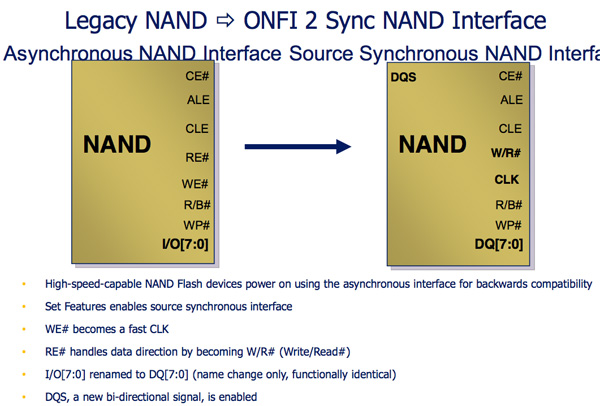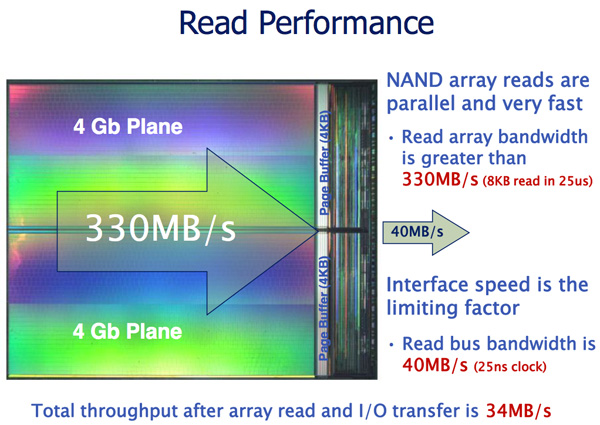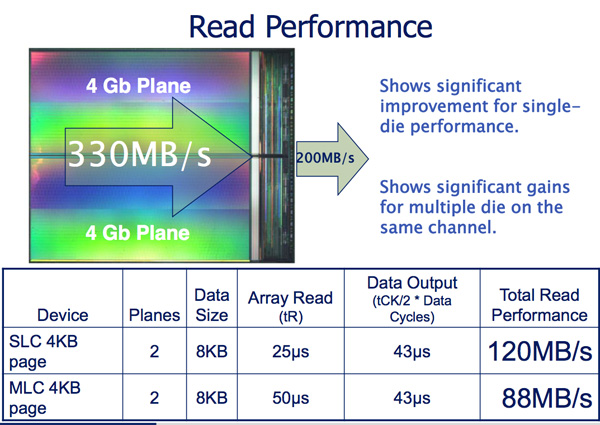SandForce Announces Next-Gen SSDs, SF-2000 Capable of 500MB/s and 60K IOPS
by Anand Lal Shimpi on October 7, 2010 9:30 AM ESTNAND Support: Everything
The SF-2000 controllers are NAND manufacturer agnostic. Both ONFI 2 and toggle interfaces are supported. Let’s talk about what this means.
Legacy NAND is written in a very straight forward manner. A write enable signal is sent to the NAND, once the WE signal is high data can latch to the NAND.
Both ONFI 2 and Toggle NAND add another bit to the NAND interface: the DQS signal. The Write Enable signal is still present but it’s now only used for latching commands and addresses, DQS is used for data transfers. Instead of only transferring data when the DQS signal is high, ONFI2 and Toggle NAND support transferring data on both the rising and falling edges of the DQS signal. This should sound a lot like DDR to you, because it is.

The benefit is tremendous. Whereas the current interface to NAND is limited to 40MB/s per device, ONFI 2 and Toggle increase that to 166MB/s per device.

Micron indicates that a dual plane NAND array can be read from at up to 330MB/s and written to at 33MB/s. By implementing an ONFI 2 and Toggle compliant interface, SandForce immediately gets a huge boost in potential performance. Now it’s just a matter of managing it all.
The controller accommodates the faster NAND interface by supporting more active NAND die concurrently. The SF-2000 controllers can activate twice as many die in parallel compared to the SF-1200/1500. This should result in some pretty hefty performance gains as you’ll soon see. The controller is physically faster and has more internal memory/larger buffers in order to enable the higher expected bandwidths.

Initial designs will be based on 34nm eMLC from Micron and 32nm eMLC from Toshiba. The controller does support 25nm NAND as well, so we’ll see a transition there when the yields are high enough. Note that SandForce, like Intel, will be using enterprise grade MLC instead of SLC for the server market. The demand pretty much requires it and luckily, with a good enough controller and NAND, eMLC looks like it may be able to handle a server workload.










84 Comments
View All Comments
Rasterman - Sunday, October 17, 2010 - link
Anyone have any guesses on sizes and prices?ABR - Tuesday, October 19, 2010 - link
I don't give much of a hoot about 6GB/s controllers and sequential performance. I'd be happier to see a 1.5GB/s interface actually utilized. Real desktop and a lot of server use consists of overlapping highly random reads, and moderately random writes. Loading an application with tons of resource files, saving documents and state to 3 or 4 directories at once, things like that. This is the whole big win of SSDs: eliminating the seek time. So I don't care about some 500MB/s number if you happen to be copying a giant file from one freshly written drive to a new blank drive. I do care about random access to a heavily used disk, and this is still sitting back in the realm of 10's of MB/s.In fact this whole hoopla about ever-increasing pure sequential transfers reminds me of the megahertz wars -- everyone shouted 10 years ago about this several hundred MHz or that GHz, meanwhile memory (and hence most actual computing) poked along at tens of MHz. Most of the progress in CPUs since that time has been in using all kinds of fancy branch prediction and pipelining structures exactly for the purpose of dealing with memory latency.
Powersupply - Wednesday, October 27, 2010 - link
Good post!kevith - Wednesday, October 20, 2010 - link
It certainly looks as if we are approaching some amazing speeds in the months to come, lovely.But what is it with RAID, that makes it pop up every now and then in storage-reviews?
"... the sort of performance you’ll be able to get through a multi-drive array will be staggering..."
As far as I can read in every single test of RAID-0 vs single drives I´ve ever read - here at Anandtech inclusive - it appears, that there is no real difference in speed with a RAID-0 setup.
In synthetic benchmarks, there is a measurable effect, but in everyday use there is none.
A lot of folks in various forums claim they have doubled their transfer-speed, some even tripled, but everytime a serious Magazine like Your own, Tom´s, BitTech or others try to find out just how great it is, it always end up the same way: No bang for the buck at all.
Are there maybe new aspects when we´re talking SSD´s, that I am not aware of?